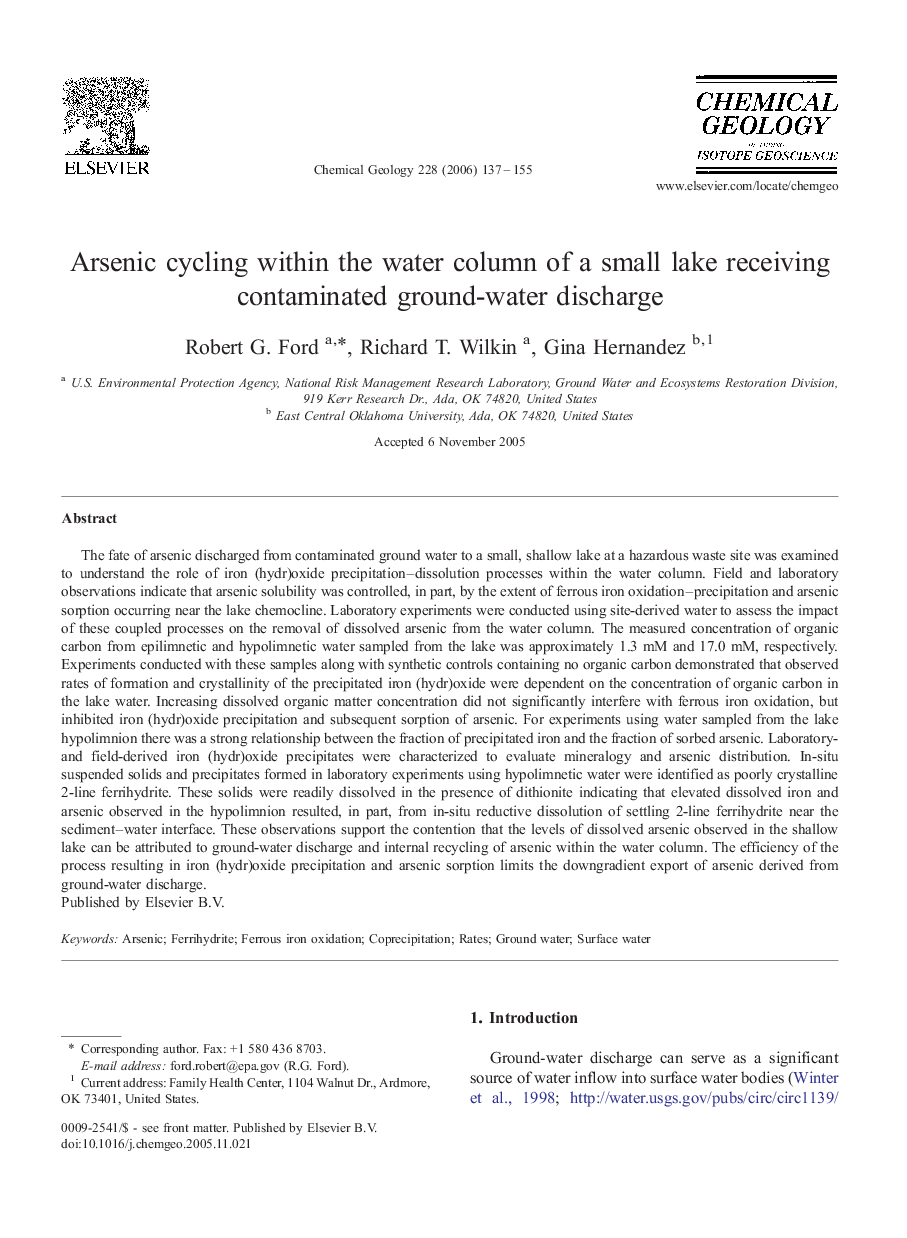| کد مقاله | کد نشریه | سال انتشار | مقاله انگلیسی | نسخه تمام متن |
|---|---|---|---|---|
| 4701356 | 1637771 | 2006 | 19 صفحه PDF | دانلود رایگان |
عنوان انگلیسی مقاله ISI
Arsenic cycling within the water column of a small lake receiving contaminated ground-water discharge
دانلود مقاله + سفارش ترجمه
دانلود مقاله ISI انگلیسی
رایگان برای ایرانیان
کلمات کلیدی
موضوعات مرتبط
مهندسی و علوم پایه
علوم زمین و سیارات
ژئوشیمی و پترولوژی
پیش نمایش صفحه اول مقاله

چکیده انگلیسی
The fate of arsenic discharged from contaminated ground water to a small, shallow lake at a hazardous waste site was examined to understand the role of iron (hydr)oxide precipitation-dissolution processes within the water column. Field and laboratory observations indicate that arsenic solubility was controlled, in part, by the extent of ferrous iron oxidation-precipitation and arsenic sorption occurring near the lake chemocline. Laboratory experiments were conducted using site-derived water to assess the impact of these coupled processes on the removal of dissolved arsenic from the water column. The measured concentration of organic carbon from epilimnetic and hypolimnetic water sampled from the lake was approximately 1.3 mM and 17.0 mM, respectively. Experiments conducted with these samples along with synthetic controls containing no organic carbon demonstrated that observed rates of formation and crystallinity of the precipitated iron (hydr)oxide were dependent on the concentration of organic carbon in the lake water. Increasing dissolved organic matter concentration did not significantly interfere with ferrous iron oxidation, but inhibited iron (hydr)oxide precipitation and subsequent sorption of arsenic. For experiments using water sampled from the lake hypolimnion there was a strong relationship between the fraction of precipitated iron and the fraction of sorbed arsenic. Laboratory- and field-derived iron (hydr)oxide precipitates were characterized to evaluate mineralogy and arsenic distribution. In-situ suspended solids and precipitates formed in laboratory experiments using hypolimnetic water were identified as poorly crystalline 2-line ferrihydrite. These solids were readily dissolved in the presence of dithionite indicating that elevated dissolved iron and arsenic observed in the hypolimnion resulted, in part, from in-situ reductive dissolution of settling 2-line ferrihydrite near the sediment-water interface. These observations support the contention that the levels of dissolved arsenic observed in the shallow lake can be attributed to ground-water discharge and internal recycling of arsenic within the water column. The efficiency of the process resulting in iron (hydr)oxide precipitation and arsenic sorption limits the downgradient export of arsenic derived from ground-water discharge.
ناشر
Database: Elsevier - ScienceDirect (ساینس دایرکت)
Journal: Chemical Geology - Volume 228, Issues 1â3, 16 April 2006, Pages 137-155
Journal: Chemical Geology - Volume 228, Issues 1â3, 16 April 2006, Pages 137-155
نویسندگان
Robert G. Ford, Richard T. Wilkin, Gina Hernandez,